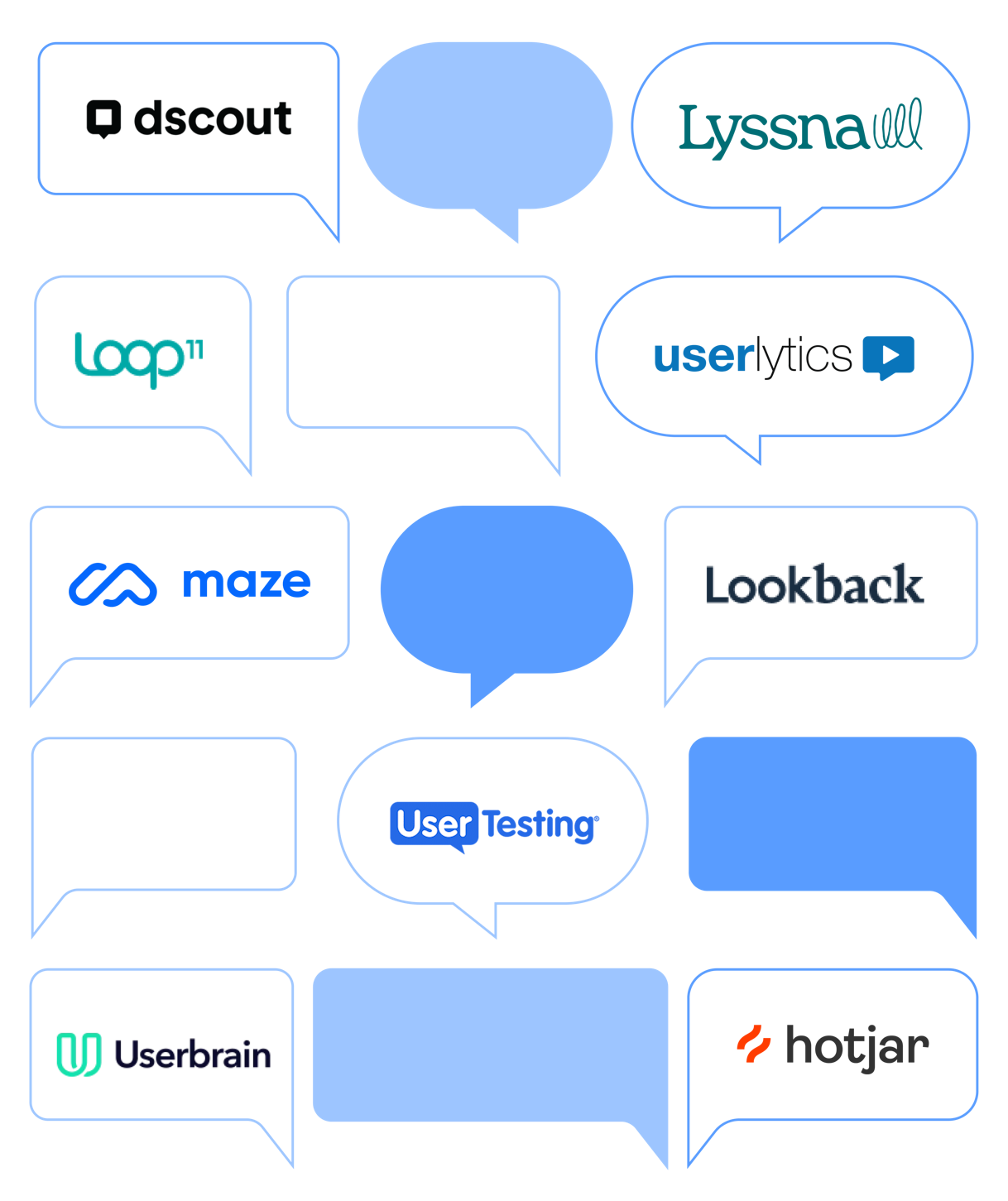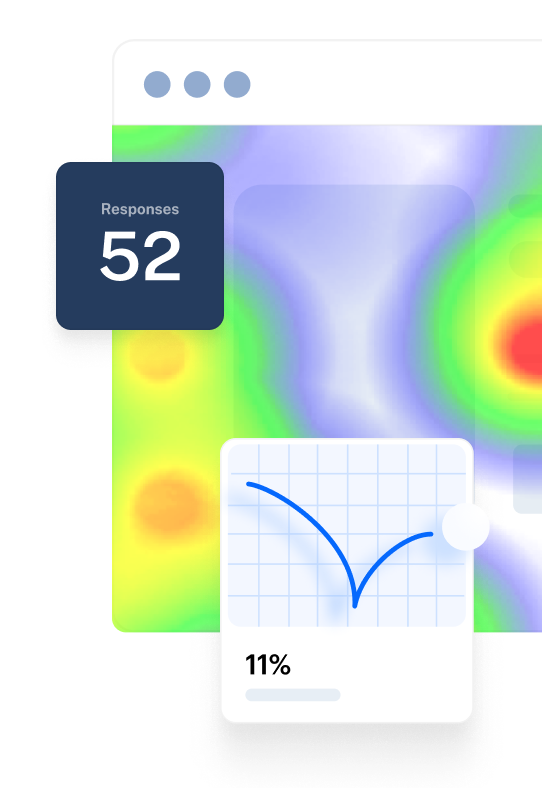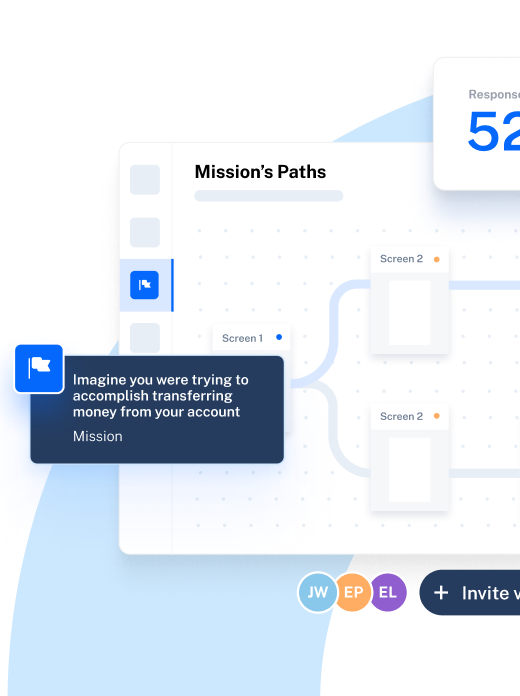Lookback is a platform that helps collect user insights on the go. With a lightweight suite of tools, it's focused exclusively on facilitating user interviews and usability testing.
While helpful, Lookback can fall short, especially when compared to the range of powerful UX research tools on the market. Whether you’re looking for a complete suite of UX research methods, or need a platform with end-to-end moderated interviews, you’re in the right place.
Lookback alternatives: An overview
We’ve handpicked the best Lookback alternatives on the market to help you find the best choice. With complete tool suites, recruitment solutions, and robust analytics features, these tools excel where Lookback falls short.
To start, here’s the best Lookback alternatives side-by-side.
Tool | Research methods and features | Pricing | G2 rating | G2 reviews |
|---|---|---|---|---|
Lookback |
| $25/month, billed annually | 4.3/5 | “Users have a lot of difficulty with the plug-in, which sometimes causes no-shows. I found out that some of the users came to the session, but we could not see each other for some reason.” |
Maze |
| $99/month, billed monthly or annually | 4.7/5 | “Maze is easy and fun to use, integrates nicely with Figma, and we love the ability to bulk upload our own research participants. The recent addition of interview studies has allowed us to consolidate all of our research projects into a single platform. We use Maze on a weekly basis and can move from identifying a research need to having critical insights in a matter of days when it previously took multiple weeks. Also, the AI features are some of the most effective and helpful I've seen as compared to other software products.” |
Lyssna |
| $75/month, billed annually | 4.5/5 | “The quality of the responses from testers was very poor. I did two tests. I had to cancel the first one as the responses coming in were useless.” |
UserTesting |
| Not shared publicly, but users report that pricing starts at $20,000 per seat/year, billed annually | 4.5/5 | “Very confusing pricing structure that feels like smoke and mirrors at times. Low level of trust in their panel - a lot of ‘testers’ that come across as falsifying screener responses for incentives.” |
Loop11 |
| $179/month, billed annually | 4.4/5 | “The limited customization options for usability tests and surveys hinder our ability to tailor the platform according to our research needs.” |
Userbrain |
| $99/month, billed annually, or pay-as-you-go testing for $45/test | 4.3/5 | “Userbrain doesn't offer built-in video editing tools. You'll need to export clips and use separate software to edit them together.” |
Userlytics |
| Plans start at $499/month, $99/session for one-off projects | 4.2/5 | “I've found that it is not an intuitive platform to learn quickly & our team ends up quite frustrated trying to jump in & run moderated interviews.” |
dscout |
| Custom (reportedly starts at $75,000/year) | 4.3/5 | “It's a complicated platform. Each time our team runs our quarterly study, we end up with questions or problems we need to reach out to customer support on." |
Hotjar |
| $32/month, billed annually | 4.6/5 | “Some features are blocked behind a payment wall and the organization of sites and companies can be confusing at times” |
1. Maze: Best for comprehensive UX research
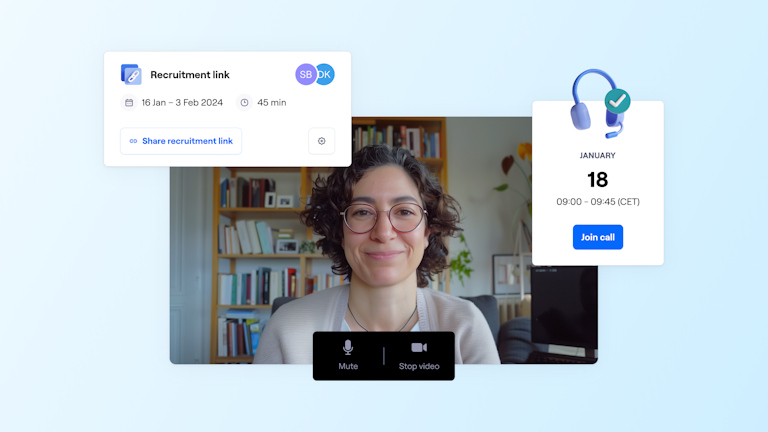
Maze is a UX research platform for uncovering in-depth user insights at every stage of the product development process. Feedback Surveys and moderated Interview Studies let you dig into deep, descriptive insights to uncover the motivations behind user attitudes. Meanwhile, usability testing methods like Prototype Testing and Live Website Testing deliver actionable feedback on user flows and experience. With Card Sorting, Tree Testing, five-second tests, heatmaps and more, Maze empowers your UX team with a comprehensive suite of unmoderated and moderated UX research tools—all on one platform.
Pros
- Extensive research methods: Maze’s complete suite of moderated and unmoderated features makes it easy to get the exact insights you need wherever you are in the product development process
- Maze AI: Streamline your UX workflow with bias-free question generation, automatic project naming, and interview analysis to highlight key learnings
- Recruit with Maze Panel: Maze’s pre-screened participant panel delivers extensive user feedback from your target demographics with 400+ filters and 130+ countries to choose from
- Participant management with Maze Reach: Once you’ve recruited research participants, Reach lets you track their participation and create custom recruitment campaigns for future studies
- In-depth analysis and data reports: Maze automatically analyzes your user feedback and puts crucial findings in customizable, visual-rich, UX research reports
- Get audio and visual recordings: Alongside moderated user interviews, Maze Clips lets you record your participant's screen and audio, for quickfire moderated usability testing sessions
- Integrate with your existing tool stack: Integrate with the tools you already use in your design and development process, such as Figma, Sketch, Adobe XD, Slack, and more
Cons
While users can access Maze through web browsers on mobile devices, there isn’t (yet) a dedicated mobile app
Pricing
Free | Starter | Organization |
|---|---|---|
$0/month - 1 study/month - 5 seats - Pay-per-use panel credits - Up to 7 blocks | $99/month or $1,188/year - 1 study/month - 5 seats Everything in Free, plus: - Unlimited blocks - Clips - AI question rephrasing - Conditional logic - PRO templates - CSV export | Custom - Custom studies - Custom seats Everything in Starter, plus: - Open card sorting - Tree testing - Interview Studies - AI follow-ups & analysis - Advanced panel targeting criteria - SSO - Dedicated CS Manager & priority support - Private workspaces (RBAC) - Custom branding options - Custom legal terms - Panel screener (coming soon) |
Maze vs. Lookback
Maze allows for holistic research that remains simple and swift to conduct, with a complete suite of UX research methods, alongside effective panel recruitment and automatic analysis.
One Maze user notes: “Maze helps me put my user research on autopilot. I don't have the time to talk to as many users as I would like, so Maze allows me to get data from my users as if I were observing them in person.”
The verdict: Opt for Maze if your team prioritizes a variety of research methods with robust reporting capabilities. With recruitment and participant management options, Maze is the best bet for teams who want a comprehensive UX research platform that can adapt and scale with their goals.
2. Lyssna: Best for unmoderated usability testing
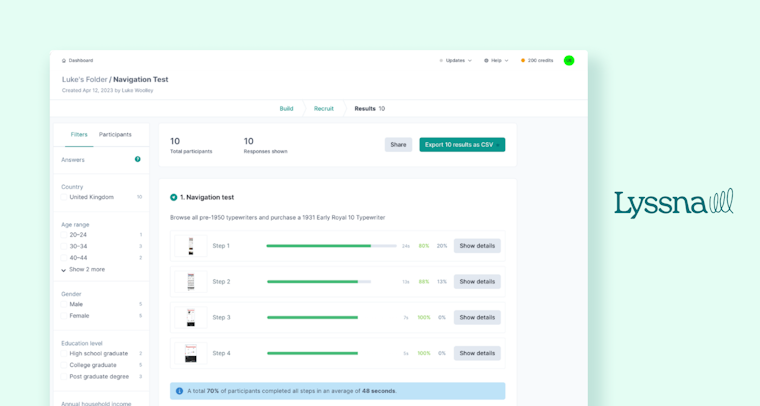
Lyssna (formerly UsabilityHub) is a UX platform that provides a range of methods for user testing. Like most tools on this list, its suite of tools comes complete with the big three: user interviews, usability testing, and surveys. Favored by beginner researchers for its basic set up, Lyssna is a solid option for smaller teams starting out.
Pros
- Offers a range of unmoderated testing, including prototypes, five-second tests, and preference tests
- An integrated research panel lets you recruit users from across 124 countries
- Lyssna offers varied pricing model options, making it a cost-effective alternative to Lookback
Cons
- While good for unmoderated testing, Lyssna has limited moderated methods for UX research studies
- Lyssna does not currently support AI-powered features, limiting teams looking to speed up their research workflows
- Users report concerns about participant quality, even stating: “The quality of the responses was very poor. I did two tests. I had to cancel the first one as the responses coming in were useless.”
Pricing
Free | Basic | Pro | Enterprise |
|---|---|---|---|
$0 - 3 Seats - Unlimited tests, surveys, and interview studies - Max 15 answers/link -Length/test: 2 mins max - Live chat support - Panel access | $75/month - 3 seats included, 10 seats max
- Unlimited responses - Length/test: 5 mins max - CSV export - Variation sets for running the same test on design iterations - Remove Lyssna branding | $175/month - 5 seats included, 15 seats max
- Conditional logic - Hidden fields - Auto-set recruitment limits - Custom branding - Team management | Custom All Pro features, plus: - Custom password policy - SAML SSO - Security audits - Priority support - Custom terms |
Lyssna vs. Lookback
While both Lyssna and Lookback are effective UX research tools, Lyssna offers a better range of unmoderated user testing. Plus, Lyssna offers recruitment and an intuitive interface, effectively streamlining UX research operations.
However, one user shares that they’ve been limited by the Figma file size allowances: “it prevented us from using [Lyssna] for a study where there were quite complex workflows involved in the prototype.” Another states that the reporting capabilities are lackluster, saying: “Lyssna’s major weakness is the presentation layer for results. It is very much a usability engineer's tool with none of the stakeholder-friendly sexiness of Maze, for example.”
The verdict: Lyssna is better for users on a budget who only need unmoderated user testing. However, for more complex user research, you might want to consider other alternatives on the list, such as Maze.
3. UserTesting: Best for big-budget projects
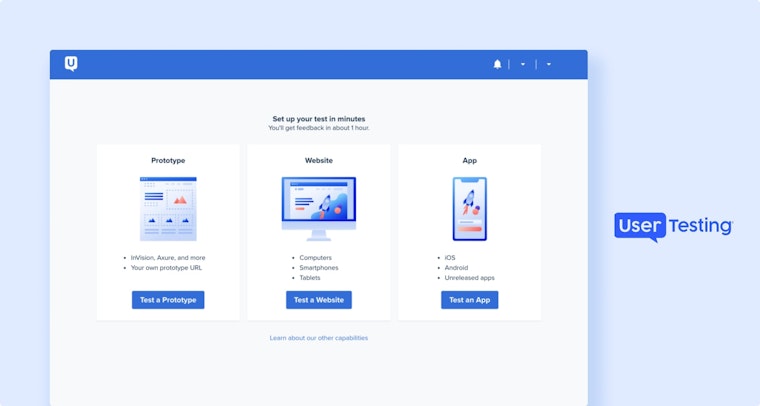
UserTesting is a UX research platform that offers both moderated and unmoderated testing. With a large participant panel, it is primarily known for moderated testing via user interviews, but does have features for usability and information architecture testing.
Pros
- Large global participant pool
- AI functionality for analyzing quantitative data
- Reporting tools allow for ready-made reports you can share with stakeholders
Cons
- Higher price point than many other user research tools on the market
- Comes with a steep learning curve, making it less ideal for quick turn-around
- Users report issues with quality of panel participants
Pricing
UserTesting doesn’t publicly share its pricing, though users have reported that plans start at approximately $20,000 per seat/year.
Essentials | Advanced | Ultimate |
- Test builder and template gallery - Demographic filters and screener - Dashboard and metrics - Transcripts - Integrations with Slack, Jira, and Trello | Everything in Essentials, plus: - Test plan and audience management - Live Conversation - Interactive path flows and click maps - Sentiment analysis - Unlimited workspaces | Everything in Advanced, plus: - Card sorting and tree testing - Onboard and manage custom audiences - Secure prototype testing - Smart tags - Approval flow |
UserTesting vs. Lookback
When comparing tool suites, UserTesting is definitely more complete than Lookback, offering a range of moderated and unmoderated research methods.
However, one user shares that “some of the features and functionality for quantitative analysis are still pretty lacking,” and that “the clunkiness of their highlight reel creation” is an issue.
While they offer a large global participant pool, users frequently complain about the quality of testers, even saying they have a “low level of trust in their panel—a lot of "testers" that come across as falsifying screener responses for incentives.”
The verdict: UserTesting beats out Lookback for range of research tools, but if you’re looking to get started ASAP or want a reliable source of research participants, consider other alternatives on this list.
4. Loop11: Best for testing on mobile and desktop
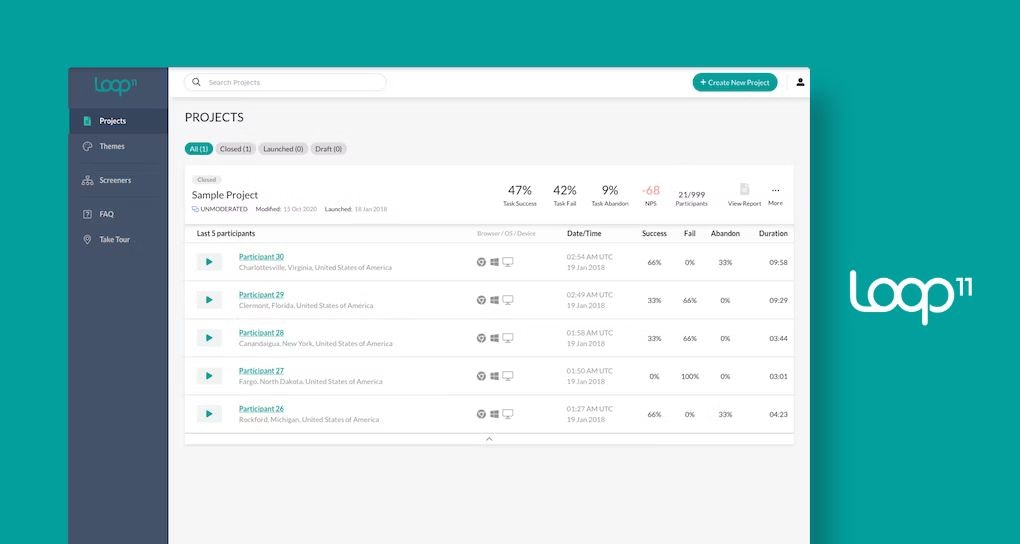
Loop 11 is a user research platform with a mixed bag of tools to help teams uncover insights. Especially notable is its search engine findability function. It also offers A/B testing and clickstream analysis.
Pros
- Offers testing on a range of devices, including mobile and desktop
- Options for moderated and unmoderated testing, with a focus on quantitative data
- Facilitates collaborative note-taking during interview sessions
Cons
- Tests cannot be edited once launched—meaning you must delete a test completely before rebuilding
- Limited integration options
- Many users state that Loop11 comes with a steep learning curve
Pricing
Rapid Insights | Pro | Enterprise |
$179/month - Moderated and unmoderated tests - Test on multiple devices - Unlimited questions, tasks, and test duration - Limited projects/month: 3 - Maximum project participants: 10 - Maximum moderated test viewers: 3 - Can bring your own users - Create highlight reels and timestamped notes - Available test methods: 5 seconds and first clicks - AI summaries and transcriptions | $358/month All Rapid Insights features, plus: - 10 projects/month - Maximum project participants: 100 - Screeners - Access heatmaps, clickstreams, and paths - Export your data - Download video and audio - Priority chat support | $533/month All Pro features, plus: - Unlimited projects, participants, and viewers - Single Sign-On (SSO) - Connect to Slack - Report segments - Enterprise security |
Loop11 vs. Lookback
Between the two options, Loop11 is better if you’re looking for statistically meaningful data for usability testing, complete with automatic analysis. However, Lookback can be a suitable option for those who just need on-the-go insights.
One Loop11 user emphasizes: “Results get mapped soon after completion with detailed analytics and outputs like heatmaps, and navigation paths.” However, another shares that “it does not provide in-depth analytics or comprehensive insights, which limits its usefulness for user testing. Additionally, the platform's own UI/UX needs to be increased to improve the user experience.”
The verdict: Go with Loop11 if you plan to focus on usability testing, but for more flexibility or continuous research, try another option.
5. Userbrain: Best if you don’t need qualitative data

Userbrain is a platform that specializes in moderated usability testing. It offers an intuitive and easy-to-use interface, with multiple question templates for quick research designs. Like many tools on this list, it comes with its own participant panel.
Pros
- Testing panel for you to recruit participants
- Pay-as-you-go options—ideal for small teams not looking to commit to a full research program
- Userbrain guarantees you’ll receive results from your test within only a few hours
Cons
- No features for moderated testing
- No native mobile or app testing
Pricing
Userbrain offers pay-as-you-go pricing at $45 per test, along with a few plan options:
Free | Starter | Pro | Agency |
- Get testers on demand - Test with your own users - 5 collaborator seats | $99/month, billed annually Everything in the Free plan, plus: - 36 testers/year included - Test with your own users - 5 collaborator seats - AI insights and notes - Highlight clips - Automated test reports | $299/month, billed annually Everything in Starter, plus: - 120 testers/year included - Test with your own users - 20 collaborator seats - AI Insights and notes - Highlight clips - Automated test reports | $799/month, billed annually Everything in Pro, plus: - 360 testers/year included - Test with your own users - 50 collaborator seats - AI insights and notes - Highlight clips - Automated test reports |
Userbrain vs. Lookback
While Lookback has both moderated and unmoderated methods, Userbrain only lets you perform unmoderated tests. However, Userbrain is specifically designed to get insights quickly, complete with a turnaround guarantee.
One user emphasizes that you can “jump into getting user insights without going through the whole rigmarole of meeting with the sales team, going through lengthy contract negotiations, etc.” Some users do, however, wish for a more organized workspace, as “things can easily get a little confusing and disorganized with a few different collaborators.”
The verdict: Go with Userbrain if you need a lightweight, unmoderated user research tool to dip into now and then for quick insights. If you need moderated capabilities to get deeper insights, more robust tools like Lyssna or Maze will serve you better.
6. Userlytics: Best for device-specific testing
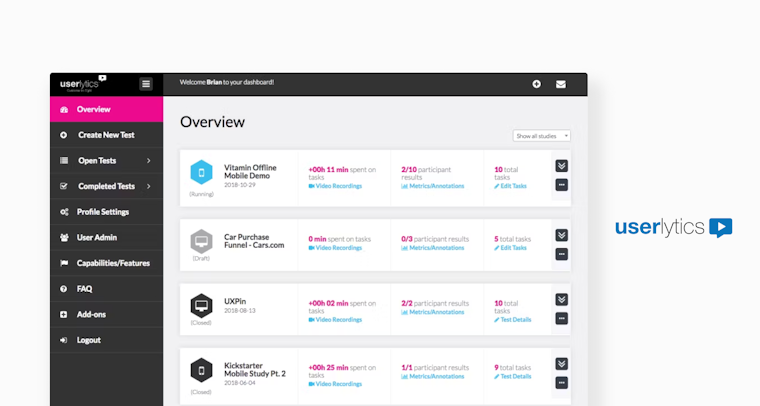
Userlytics is a UX research platform that offers moderated and unmoderated methods for both qualitative and quantitative insights. From device-specific testing to a panel base of over two million participants, it’s a well-rounded platform if you’ve got the budget.
Pros
- Large panel of over two million users
- Integrates with design tools, such as Figma, Adobe XD, and InVision
- Offers quick session recordings for key moments
Cons
- One of the more expensive solutions on this list
- Lacks multilingual transcription options for interviews
Pricing
Userlytics pricing can be confusing—it broadly depends on whether you’re using the tool regularly, and if you’ll be providing your own research participants.
Project-based | Premium | Advanced | Enterprise | Custom |
$99/session One-off projects | $499/month - Unlimited unmoderated (30 minutes) sessions - Unlimited quantitative sessions (15 minutes) - Bring your own participants | $999/month - Unlimited unmoderated (60 minutes) sessions - Unlimited quantitative (60 minutes) sessions - 50 moderated sessions - Bring your own participants - Panel participant sessions available at $19/session | Usage-based approach, pricing starts at $3,500/month - Unlimited Admin & User accounts | Custom pricing and feature set |
Userlytics vs. Lookback
Userlytics offers multiple research methods that Lookback doesn’t, with tools for testing information architecture, like card sorting and tree testing tools.
One Userlytics user notes: “The platform offers a full range of tools for conducting remote usability tests. I used it multiple times in my studies,”. Meanwhile others aren’t as pleased, with some reviews commenting on the steep learning curve and stating that “it’s not an intuitive platform to learn quickly.”
Compared with other tools on this list, it’s also very costly, with Userlytics’ cheapest subscription still coming in at a full $400/month more than Maze’s Starter Plan.
The verdict: Userlytics is a decent UX research tool with a range of methods, but the price point makes it hard to compare with other options on the market. Unless money is no object, consider looking at other comprehensive solutions like Maze, UserTesting, or Lyssna.
7. dscout: Best for diary studies
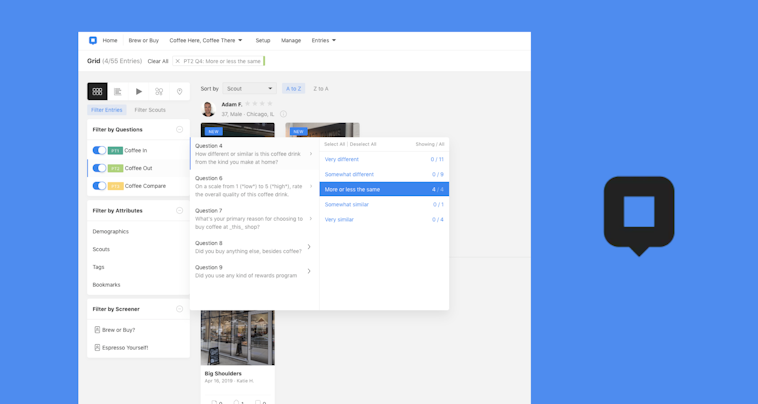
dscout is a user research platform that focuses on giving teams qualitative insights into their websites and digital products. It offers a range of valuable methods, including diary studies. dscout also provides a moderately large panel of vetted testers.
Pros
- Multiple analytics features such as automatic transcripts and video playlist editing
- Express Missions promises to deliver insights within 24–48 hours
- Integrates with collaboration tools like Slack and Miro
Cons
- Users can face challenges when recruiting users from outside the US and Canada, which can limit global studies
- Lack of features for gathering quantitative data
Pricing
dscout offers three pricing plans: Researcher, Team, and Enterprise. They don’t share their pricing publicly, but a Reddit user has reported the Enterprise plan starts at $75K/year.
dscout vs. Lookback
dscout specializes in providing users with descriptive insights through qualitative research methods. While it lacks many of the usability features Lookback has, users can capture in-the-moment behaviors through diaries, interviews, and surveys.
A dscout user states: “This is not just a tool for diary studies anymore, it truly is a one-stop shop for qualitative research.” Despite this claim, other users list its missing quantitative features and participant recruitment and management limitations as major drawbacks to consider.
The verdict: Go for dscout if you want to conduct qualitative research and have no need for quantitative research capabilities.
8. Hotjar: Best for behavioral analytics

Known for its heatmaps, session recordings, feedback widgets, and surveys, Hotjar is a platform for uncovering product and user behavior insights. Its many product analytics features are especially helpful for understanding how a digital experience can be optimized to improve conversion rates, user engagement, and user satisfaction.
Pros
- Specialist heatmapping tools
- Surveys and feedback tools for qualitative data
- Clicks, taps, and scrolling behavior provide additional insights
Cons
- Can be less cost-effective for enterprises or sites with high traffic
- Not designed as a comprehensive research platform—missing key user research methods like prototype testing and card sorting
Pricing
Free | Plus | Business | Scale |
$0 - Unlimited heatmaps | $32/month Everything in Free, plus: | $80/month Everything in Plus, and: | $171/month Everything in Business, and: - Funnels and Trends - Console tracking (Errors) - Entered text and error filters - Hotjar API: automate user lookup and deletion - Webhooks - SAML single sign-on (SSO) - Dedicated customer success manager - Priority support |
Hotjar vs. Lookback
Hotjar and Lookback serve two distinct purposes in user research. Hotjar focuses on user behavior and product analytics, making it ideal for data-backed decisions and design improvements. Lookback, on the other hand, focuses on real-time, moderated usability testing.
One Hotjar user says: “The insights we gain from Hotjar’s heatmaps, session recordings, and feedback polls are invaluable.” It is worth noting, however, that other users argue that Hotjar slows down their site performance, which hinders the user experience they’re setting out to optimize in the first place.
The verdict: Go for Hotjar If you want to understand user behavior and make data-backed product design decisions. If you’re looking for more of an all-rounder, consider another option.
Why look for an alternative to Lookback?
While Lookback gives you some tools to get started with UX research, there are a lot of missing features—making it a lackluster platform for scaling your user research operations.
Lookback lacks crucial UX research methods
The Lookback suite centers on usability testing and user interviews. While these UX methods are crucial, there’s a plethora of other ways to get user feedback and glean insights. Lookback doesn’t offer card sorting, tree testing, surveys, or heatmaps, significantly limiting the breadth and depth of your research.
For example, card sorting and tree testing can help you study your website’s information architecture, while surveys help you reach a wider range of participants at once. Analytics like heatmaps give you insight into where users click. With a stronger suite of features, you can conduct more research.
Lookback doesn’t offer a user recruitment solution
Lookback can be effective for studying users—provided you can recruit your own. It doesn’t come with a panel or recruitment tool to search for vetted users, so UX teams have to do that themselves or pair Lookback with a recruitment tool.
If you’re out to streamline your workflow and your tech stack, this shortcoming is a major inconvenience. Tools on our list like Maze and dscout offer their own recruitment panels.
Lookback provides limited analysis options
Effective UX research doesn’t stop at getting feedback. You still need to analyze user data for insights. However, Lookback doesn’t have many features that support analysis, meaning you’ll need to analyze manually.
Besides costing you valuable time and effort, it’s easy to make mistakes, which can lead to skewed insights and, ultimately, making the wrong design decisions. Plus, who wants to mess around with plugging data into an Excel sheet?
How to choose an alternative to Lookback
With so many platforms to choose from, selecting the ideal Lookback alternative can seem overwhelming. To narrow down your search and find the best options, break it down to:
- Features: What key functions does your team require for UX research? For example, a tool like Maze is a good option if you need access to a wide range of research methods, while Hotjar specializes in user behavior analytics. Consider what you’re testing and the methods you need to test it.
- Budget: Determine how much you’re willing to spend and the cost-effectiveness of each platform. For example, there’s no point splurging on an expensive tool like UserTesting if you don’t plan on using a good deal of features.
- Integrations: Your chosen tool should be able to fit in with the rest of your tech stack. A tool that integrates with design and collaboration platforms ensures you have a seamless and streamlined workflow.
Build fast and right with Maze
While Lookback can certainly get the job done, it might not be your best UX research option going forward. Plenty of other platforms offer both moderated and unmoderated user research methods with a more comprehensive suite of tools. Plus, Lookback’s lackluster analytics and lack of a participant panel make it one step short of a complete research tech stack.
Here’s where Maze can help.
Maze is a comprehensive leading user research platform that empowers your team to uncover game-changing insights. With a powerful suite of both moderated and unmoderated methods, vetted recruitment panel, and robust analytics, Maze makes UX research easy.
Whichever tool you opt for, make sure to focus on one key aspect: improving the user experience for your customers. Rome wasn’t built in a day, and the ideal user experience won’t be, either. Be patient, remain focused on your goal, and start taking small steps to optimize your UX.
Frequently asked questions about Lookback alternatives
Are there other sites like Lookback?
Are there other sites like Lookback?
Yes! There are a few Lookback competitors that offer similar UX research methods, and in some cases, more. Some examples include Maze, UserTesting, Loop 11, and Hotjar.
What is Lookback used for?
What is Lookback used for?
Lookback is a UX research tool used for conducting both moderated and unmoderated usability testing. Users can observe participants’ interactions with products, gather qualitative insights, and collaborate together based on feedback.
Is Lookback the best user research tool?
Is Lookback the best user research tool?
The best user research tool for your team depends on a number of factors. There are other UX platforms like Lookback that offer the same moderated and unmoderated usability testing along with a more complete suite of tools. Lookback also lacks analytics features and a panel for recruiting participants.



